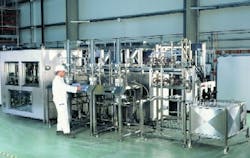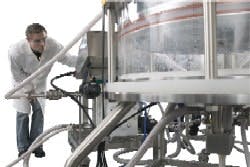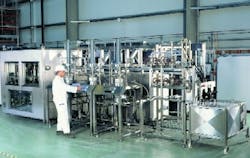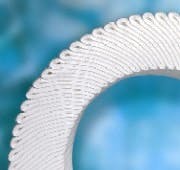For manufacturing therapeutic proteins, chromatography is nothing less than the Holy Grail of bioseparations, notes Howard Levine, Ph.D., President of BioProcess Technology Consultants (Acton, Mass.). As competition heats up and biopharma awaits the emergence of biogenerics, cost-consciousness is driving new bioseparation technologies that minimize waste and boost output. Higher flow velocity and binding capacity mark todays chromatography systems, while disposable and membrane chromatography systems (see Disposables and Membrane Adsorbers, below) are helping to reduce cost and waste even further.At the same time, economics is taking chromatography at least, in its continuous form where it has rarely gone before, into more small-molecule process niches (see Small-Molecule Chromatography: A Hard Sell, below).Overall, whether in large or small molecule production, chromatography technology is driven by the need to minimize process waste. Biotech can no longer accept 50% losses per step, says John Jenco, Ph.D., senior staff scientist at Pall Life Sciences (East Hills, N.Y.).Downstream bioprocessing is also racing to keep up with tremendous gains achieved upstream. Weve seen huge improvements both upstream and downstream, but generally, downstream purification has not kept pace with upstream production, noted Duncan Low, scientific director at Amgen (Thousand Oaks, Calif.) at Septembers IBC BioProcess International conference in Boston.Chromatography possesses poor economics of scale compared to fermentation, says Low. You can often scale fermentations without changing the bioreactor footprint, but that just isnt possible with chromatography columns, he says.According to Low, protein titers have increased thousandfold, from 5-50 mg/L in 1980 to 5g/L and higher today, with a target of 10-20 g/L for the next three to five years. Higher titers generate lower volumes per quantity of protein, which aids downstream operations, as well as more biomass, which does not.Purification experts have responded with numerous improvements, including:
- process integration and intensification;
- the use of compound filters during clarification;
- more efficient resin utilization (including reuse) and higher product recovery;
- alternative downstream strategies that employ membrane adsorbers, liquid-liquid separations, and of course, disposables.
- Simulated moving bed (SMB) chromatography Developed in the 1960s as a continuous purification technique for the oil industry, SMB has since been adopted by food, chemicals and pharmaceuticals, and most recently, in biotech (Pharmaceutical Manufacturing, Nov./Dec. 2004, p. 27). SMB addresses several concerns of drugmakers with chromatography, and offers a number of advantages, using less solvent per unit of purified material, and offering better resolution than that of batch chromatography.
In the 1990s, Novasep (Boothwyn, Pa.) developed and introduced SMB to pharmaceutical companies. Its process-scale continuous SMB systems use multiple columns of up to one meter in diameter.
- Varicol (pictured above) Another Novasep process, it is said to be 20% more efficient than SMB. Where SMB units use four columns or zones that rely on counter-current movement of solid and liquid phases, Varicol combines cocurrent and countercurrent motion and requires one or two fewer columns than SMB to achieve similar performance. The method is particularly effective in the resolution of enantiomers from racemic mixtures.
Both Varicol and SMB are binary separators, which means that they are only capable of purifying mixtures of two components (exactly what is needed for racemate resolution). That is why compounds undergoing chiral chromatographic resolution are frequently purified by crystallization first to eliminate fast- and slow-eluting impurities.
Novasep also sells preparative and process high-performance liquid chromatography (HPLC), operating in batch mode, for small to large peptides using columns of up to 1.6 meters in diameter. The company has entered a biochromatography alliance with Rohm and Haas Co. (Philadelphia) to develop biomolecule separations based on high-performance resins. The collaboration has developed a few processes for peptides but has not yet tackled large molecules like MAbs.
Since the cost of discarding the undesirable enantiomer is so high, chiral chromatography only makes sense when chirality can be recycled through re-racemation and another pass through the chiral column. Recycling can up yields to 90% and above, provided the chiral intermediate does not racemize spontaneously. You have to think of chiral chromatography within a global synthetic pathway, says Jean Blehaut, president of parent company Novasep SA. - Recycle or steady state recycle chromatography This continuous method differs from SMB in several ways:
- it uses only one column instead of four;
- its capacity and throughput are somewhat lower;
- it is more at home in development labs or early research than in a manufacturing suite.
- it uses only one column instead of four;
Abbott Streamlines Downstream Bioprocessing Abbott Laboratories (North Chicago, Ill.) flagship purification platform for MAb purification uses cation exchange rather than affinity capture, changing the game for both feedstock and subsequent downstream steps. According to James Stout, Ph.D., group leader for purification, process sciences, the major hurdle in early downstream processing becomes host cell removal, followed by protein impurities that behave similarly to target molecules (perhaps a result of not using affinity capture). Abbott also encounters protein aggregation and fragmentation, host cell protein variability, and protein hazing and precipitation, in addition to the usual ongoing capacity issues. The advent of super-resins that bind 100 grams or more of protein per liter of resin, without compromising resolution or throughput, has helped harmonize upstream and downstream capacities. Abbott is also looking seriously at older unit operations such as crystallization, selective precipitation or liquid-liquid extraction to complement chromatography by cutting down process volumes, impurities or both. Abbott believes that process analytics will eventually help lessen the mismatch between upstream and downstream capacities. Process mapping and chromatography profiling for impurity removal can provide feedback for operating cell culture to reduce certain side-products. Certainly, chromatography is at the center of this assessment from both a processing/purification and analysis standpoint, Stout adds. Membrane adsorbers are part of a possible replacement strategy for traditional column chromatography, but a head-to-head comparison still favors chromatography, says Stout. |
Latest from Automation & Control
Latest from Automation & Control









